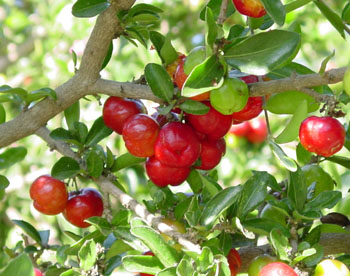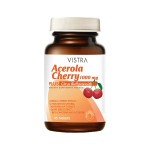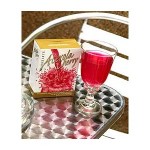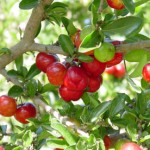Malpighia emarginata is a tropical fruit-bearing shrub or small tree in the family Malpighiaceae. Common names include acerola, Barbados cherry, West Indian cherry and wild crapemyrtle. Acerola is native from Southern Mexico, Central and South America, but now being also grown as far North as Texas and in subtropical areas – Asia and India. It is known for being extremely rich in vitamin C although it also contains vitamins A, B1, B2 and B3 as well as carotenoids and bioflavonoids which provide very important nutritive value and have possible antioxidant uses. This vitamin C produced by the fruit is better absorbed by human organisms than synthetic ascorbic acid.
Distribution
M. emarginata is originally from Yucatán can be found in the southernmost parts of the contiguous United States (southern Florida and the Lower Rio Grande Valley of Texas), Mexico, Central America, the Caribbean, and South America as far south as Peru and Minas Gerais in Brazil. It is cultivated in the tropics and subtropics throughout the world, including the Canary Islands, Ghana, Ethiopia, Madagascar, Zanzibar, Sri Lanka, Taiwan, India, Java, Hawaii, and Australia.
Adaptation
Acerola can be propagated by seed, cutting and other methods. M. emarginata prefers dry sandy soil and full sun and it’s very susceptible to cold (cannot endure temperature lower than 30°F). Because of its shallow roots, it has very low tolerance to winds.
Description
Acerola is an evergreen shrub or small tree with spreading branches on a short trunk. It is usually 2–3 m (6.6–9.8 ft) tall, but sometimes reaches 6 m (20 ft) in height.
Leaves
The leaves are simple ovate-lanceolate, 2–8 cm (0.79–3.1 in) long, 1–4 cm (0.39–1.6 in), and are attached to short petioles. They are opposite, ovate to elliptic-lanceolate, and have entire or undulating margins with small hairs, which can irritate skin.
Flowers
Flowers are bisexual and 1–2 cm (0.39–0.79 in) in diameter. They have five pale to deep pink or red fringed petals, ten stamens, and six to ten glands on the calyx. There are three to five flowers per inflorescence, which are sessile or short-peduncled axillary cymes.
Fruit
The fruit is a bright red drupe 1–3 cm (0.39–1.2 in) in diameter with a mass of 3–5 g (0.11–0.18 oz). Drupes are in pairs or groups of three, and each contains three triangular seeds. The drupes are juicy and very high in vitamin C (3-46g kg-1) and other nutrients. They are divided into three obscure lobes and are usually acid to subacid, giving them a sour taste, but may be sweet if grown well. While the nutrient composition depends on the species and environmental conditions, the most common components of acerola and their concentration range are as follow: proteins (2.1-8g), lipids (2.3-8g), carbohydrates (35.7-78g), calcium (117 mg), phosphor (171 mg), iron (2.4 mg), pyridoxine (87 mg), riboflavin (0.7 mg), thiamine (0.2 mg), water (906-920g) and dietic fibre (30g)
Uses
As food
The fruit is edible and widely consumed in the species’ native area, and is cultivated elsewhere for its high vitamin C content. There are 1677.6 mg of vitamin C in 100 g of fruit.
- Fruit can be used to make juices and pulps, both very rich in vitamin C and antioxidants;
- Acerola fruit can be used to produce vitamin C concentrate;
- Baby food and juice
A comparative analysis of antioxidant potency among a variety of frozen juice pulps was carried out, including the acerola fruit. Among the eleven fruits’ pulps tested, acerola was the highest-scoring domestic fruit, meaning it had the most antioxidant potency, with a TEAC (Trolox equivalent antioxidant activity) score of 53.2 mmol g.
Absolut Vodka released Absolut Los Angeles, a limited-edition spirit flavored with acerola, açai, pomegranate, and blueberry, in July 2008.
Chiquita’s Strawberry-Banana C-Optima drink, sold in 4-packs of 125ml apiece in Belgium and Germany, advertises on its lid that it contains 3 acerolas and 200Â mg of Vitamin C.
Other uses
Acerola is a popular bonsai subject because of its small leaf, fruit and fine ramification. It is also grown as an ornamental and for hedges.
Malpighia glabra is one of three ingredients in a propriety herbal medicine for allergic rhinitis.
Thanks to its extremely high vitamin C content, the cherry can help boost your immune system, strengthen your liver, improve your skin condition, and increases your body’s ability to repair tissues quickly. It also helps you prevent colds, infections, hair loss, and dental problems.
The cherry contains anthocyanins – substances which are highly anti-inflammatory in nature. So, it is very good at relieving headaches. Eating an acerola cherry can have the same effect as taking ibuprofen or aspirin for your headache.
The cherry is an excellent source of vitamin A, which is a known antioxidant. 100 grams of an acerola cherry contains up to 1017 IU of carotene. A regular intake of vitamin A tends to improve your vision and reduces the risk of cataracts and other such eye problems. Since it is a powerful antioxidant, it fights the free radicals which cause the maximum damage to your skin. As a result, you can stay away from skin problems.



